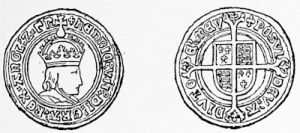
A series of marriages and deaths now claim our attention [after the failure of the Perkin Warbeck plot]. Joanna, the second daughter and ultimately the heiress of Ferdinand and Isabella, was married in 1496 to the Archduke, Philip of Burgundy, the son of Maximilian. This was to have the effect of joining the Burgundian with the Spanish heritage under the sway of the child of the marriage, Charles — who became famous as the Emperor Charles V — although the Austrian heritage was transferred to his brother, Ferdinand.
This marriage made Henry the more urgent in desiring the union of the younger daughter, Katharine of Aragon, to his own heir, Arthur, Prince of Wales. The marriage treaties were a matter of long haggling and dispute.
Six months after the marriage was actually completed, in 1501, Arthur died, and the second son, Henry, became heir to the. throne. At once it became a primary object with the king to secure Katharine for the young Henry. Such a marriage was contrary to canon law, and there was no wholly satisfactory precedent for a papal dispensation in a precisely similar case. Nevertheless, a dispensation was actually obtained from Pope Julius II., on tire ground that the marriage was never consummated; still, the wedding did not actually take place until after the accession of Henry VIII.
The next marriage which had an important bearing on subsequent history was that which Henry negotiated between his eldest daughter, Margaret, and James IV of Scotland. James had made himself troublesome over the affair of Perkin Warbeck, and Henry was anxious to provide by the marriage a permanent basis for friendly relations with the Northern Kingdom; nor did he shrink from recognising the ultimate possibility, realised a hundred years afterwards, that an actual union of the Crowns might some day result. So James Stuart married Margaret Tudor, and their great-grandson, James VI of Scotland, became also, in 1603, James I. of England. Henry, however, failed to obtain from James a decisive promise of the dissolution of the long-standing alliance between Scotland and France.
The death of Henry!s own wife, Elizabeth of York, removed from him one who seems always to have exercised a beneficial influence on his moral character. Both Henry and Ferdinand of Aragon conspicuously degenerated, morally, after the death of their respective wives. In Archbishop Morton also Henry had lost an admirable minister, whose influence had probably checked the development of the sordid side of his character.
The closing years of Henry's life were mean and ugly, and colour unduly the popular impressions of his whole reign. To them belong unsavoury records of extortion and corruption, and records still more unsavoury; as of the king's possible design of himself marrying his widowed daughter-in-law, and his undoubted proposal to marry her sister Joanna when she had become a widow by the death of Philip of Burgundy, although all the world knew that she was insane.
For full fifteen years of his reign Henry's record had been emphatically a clean one, marred only at its close by a single act of gross injustice, the execution of Warwick, for no crime except that he was a possible figureÂhead for Yorkist plots. Had he died before his wife he would have been remembered as a great, though hardly as a lovable, ruler; since he lived till 1509 we are apt to think of him chiefly as the meanest of English kings.
This article is excerpted from the book, 'A History of the British Nation', by AD Innes, published in 1912 by TC & EC Jack, London. I picked up this delightful tome at a second-hand bookstore in Calgary, Canada, some years ago. Since it is now more than 70 years since Mr Innes's death in 1938, we are able to share the complete text of this book with Britain Express readers. Some of the author's views may be controversial by modern standards, particularly his attitudes towards other cultures and races, but it is worth reading as a period piece of British attitudes at the time of writing.
History
Prehistory - Roman
Britain - Dark Ages - Medieval
Britain - The Tudor Era - The
Stuarts - Georgian Britain - The Victorian Age
